Types of Plane in Engineering Drawing
An engineering drawing is a subcategory of technical drawings. The purpose is to convey all the data necessary for manufacturing a production or a part.
Engineering drawings use standardised language and symbols. This makes understanding the drawings simple with little to no personal interpretation possibilities.
Then let's look at the different line and view types you will run across in the engineering discipline.
The Purpose of Engineering Drawings
Equally already said, such a technical drawing has all the information for manufacturing a function or welding and edifice an assembly. The info includes dimensions, part names and numbers, etc. And then one time a manufacturing engineer gets the drawing, he can start the product process without a 2d thought.
First, we have to suspension for a second and address our ain customers here to avoid confusion. The drawings you submit for instant pricing and manufacturing in our system practise not need whatsoever of this. The same applies to 3D models. CAD files and drawings made according to our pattern tips include all the necessary data for making your production. The only time we inquire for a drawing is if you want to specify tolerances.
Still, knowing all the rules and nuts of formatting is an absolute must in the industry, as traditional manufacturing companies still need detailed drawings.
How to Brand Drawings?
A few decades ago, you would have had to sit down at a cartoon board covered with papers of different size, rulers, callipers, etc. Today, all these instruments are yet expert for manual drafting but no contemporary manufacturer really wants such drawings.
Why? Considering virtually of the machinery uses CNC systems that can read the information straight from the files and produce a cut program accordingly. Drawings done by hand would just add a lot of manual work for manufacturing engineers.
So, we are left with only i option really – every engineer should utilize CAD (figurer aided design) software because of its many advantages.
Yous can, of course, use CAD for making drawings from scratch. Only the easier option is to first brand a 3D model and create the drawings from that, as the programs generate the views with only a few clicks. All you lot need to do is add the dimensions. Having models also makes updating the drawings for revisions simple.
Basic Components of an Engineering Drawing
Let's encounter what makes upwards an engineering drawing. A single drawing includes many elements with quite a few variations to each of them. And so let's have a closer look hither.
Different Types of Lines
Not every line on an engineering drawing is equal. The different options make it possible to prove both visible and hidden edges of a part, centre lines, etc.

The most mutual is a continuous line, also known equally a cartoon line. This represents the physical boundaries of an object. Put simply, these lines are for drawing the objects. The line thickness varies – the outer profile uses thicker lines and inner lines are thinner.

Hidden lines can show something that would not be otherwise visible on the drawings. For example, hidden lines may show the length of an internal pace in a turned part without using a department or a cutout view (nosotros explain both later on).

Centre lines are used to show pigsty and the symmetric properties of parts. Showing symmetricity can reduce the number of dimensions and make the drawing more centre-pleasing, thus easier to read.

Extension lines annotate what is being measured. The dimension line has ii arrowheads between the extension lines and the measurement on superlative (or inside, similar in the epitome in a higher place) the line.

Interruption lines betoken that a view has been broken. If you lot have a part that is 3000 mm long and x mm wide with symmetric properties, using a break-out makes gives all the info without using as much space.
While a proficient way for giving information to people, CNC machines need total views in order to cutting the parts. Otherwise, the manufacturing engineer has to reconstruct the whole part from the measurements.
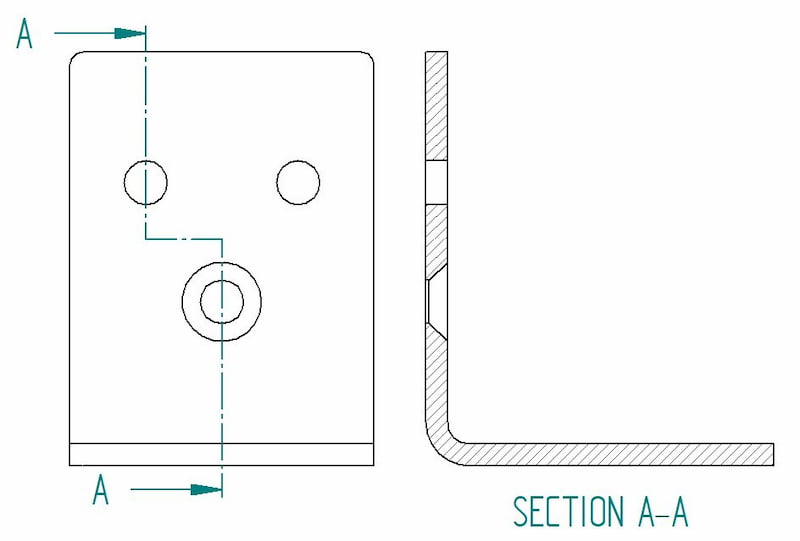
When using a cutout view, the cut plane lines show the trajectory of the cutout. Here y'all tin see that the A-A cutting line brings both types of holes into the view.
Types of Views
So let's take a closer look at the different types of views that are frequently nowadays in a manufacturing cartoon. Each serves a certain purpose. Carry in heed that calculation views should follow the aforementioned logic as dimensioning – include equally footling as possible and every bit much every bit necessary.
A tip for skilful engineering exercise – only include a view if it contributes to the overall understanding of the design.
Isometric View
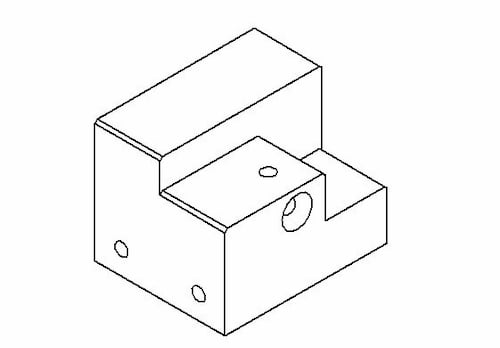
Isometric drawings show parts as three-dimensional. All the vertical lines stay vertical (compared to front view) and otherwise parallel lines are shown on a 30-degree angle.
The lines that are vertical and parallel are in their true length. Which means you can utilise a ruler and the scaling of the cartoon to easily measure the length directly from a paper drawing, for example. The same does not apply to angled lines.
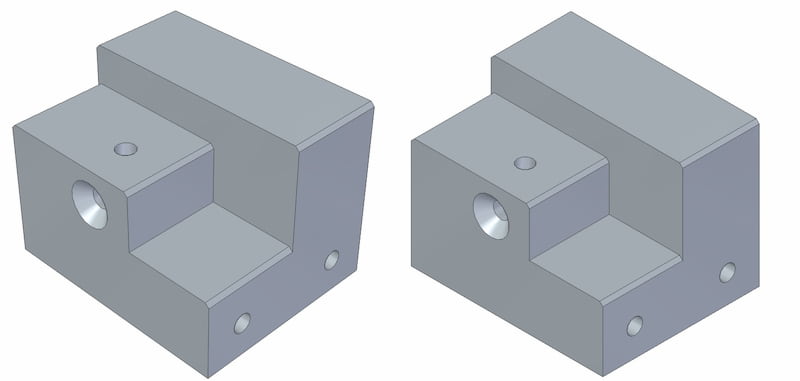
It is important to distinguish the isometric view from a perspective view. A perspective view is an creative one that represents an object as it seems to the middle. Engineers stay truthful to the dimensions rather than optical illusions.
Orthographic View
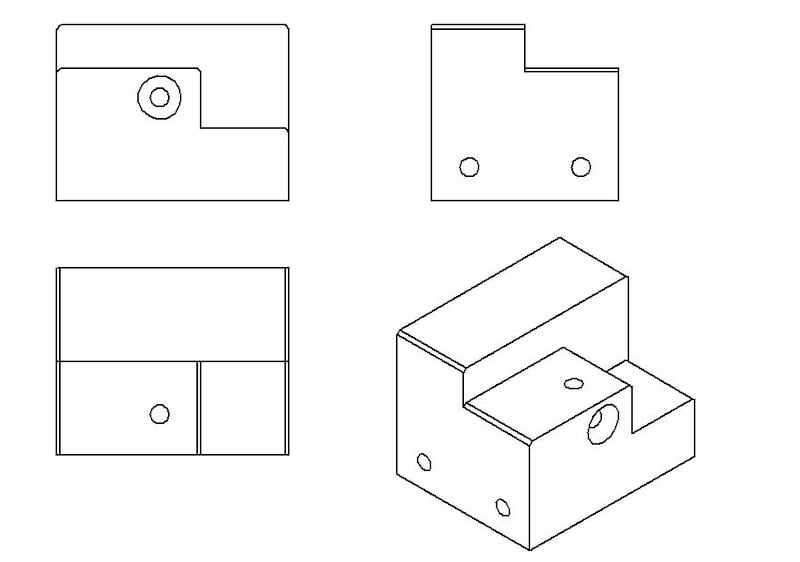
This is the breadstuff and butter of an technology drawing. An orthographic view or orthographic projection is a way of representing a 3D object in two dimensions.
Thus, a 2nd view has to convey everything necessary for part production. This kind of representation allows avoiding whatever kind of distortion of lengths.
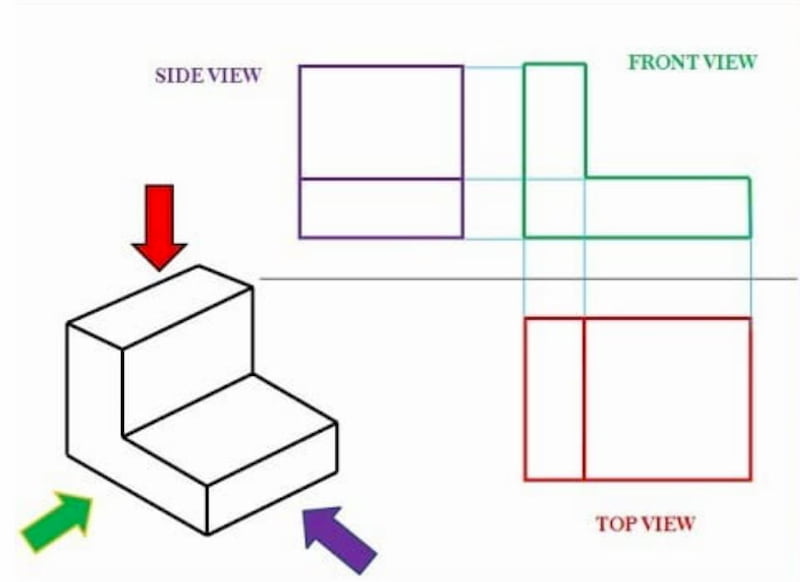
The most common way to communicate all the data is by using three different views in a multiview drawing:
- Front end view
- Top view
- Side view
It may be possible that some boosted views are necessary to show all the info. But over again, less is more than.
The positioning of the views differs a bit regionally. For example, wait at the epitome beneath to compare the US and ISO layouts.

The one on the left is called first-bending projection. Hither, the top view is under the front view, the right view is at the left of the front view, etc. The ISO standard is primarily used in Europe.
On the right, y'all can see a third-bending project. The right view is on the right, top view on the top of the front view, etc. This organization is particularly popular in the US and Canada.
Apartment Blueprint
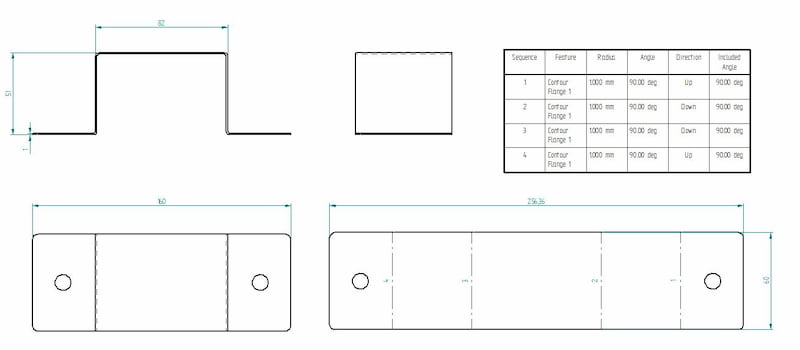
If y'all are making a folded canvass metallic part, do non forget to add a flat blueprint view. The cut task comes earlier bending. When it comes to our customers, the easiest way is simply to upload a Step file without any accompanying drawings.
Creating a flat pattern view is usually pretty simple. But be aware that you are using the sheet metallic surroundings when making sheet metallic parts in CAD. There you have the selection to "generate a flat pattern" which yous can easily add to the main drawing.
If yous are using the standard part environs, the same pick is not bachelor. All the same, many CAD programs accept the possibility to catechumen a standard office into sail metallic if the part properties correspond to sheet metallic (east.g. uniform thickness, inside radius, etc.).
Department View

A department view can easily display some of the part features that are non evident when looking just from the commencement. Cantankerous section is the preferred option compared to subconscious lines equally it brings more clarity. The cross hatching feature is and indicator for cantankerous sectional views.
Cutout View

This is the same image we used for illustrating the section view. With ane slight departure – the side view includes cutouts. Cutouts can reduce the number of unlike views on a single drawing.
Thus, we could easily delete the department view and add all the necessary dimensions to cutouts.
Item View
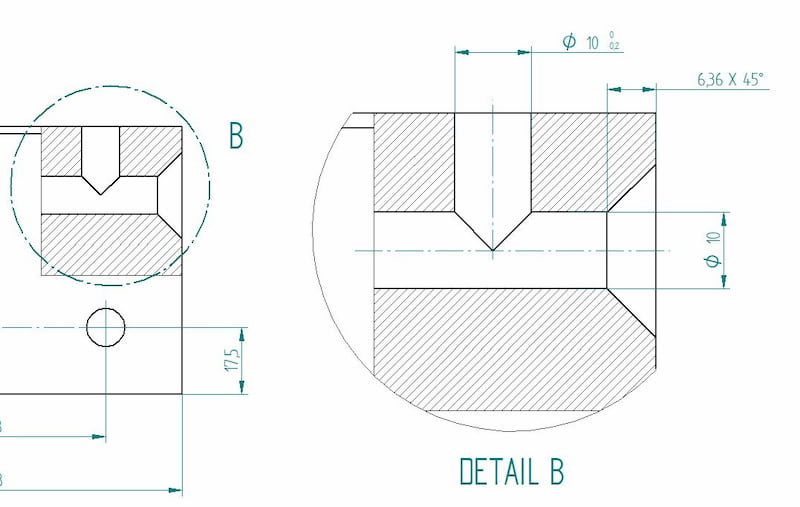
The item view gives us a close-up of a selected section of a larger view. This tin exist especially useful if an otherwise large part includes many of import dimension in a pocket-size area. Using the detail view improves the readability of these measurements.
Auxiliary View
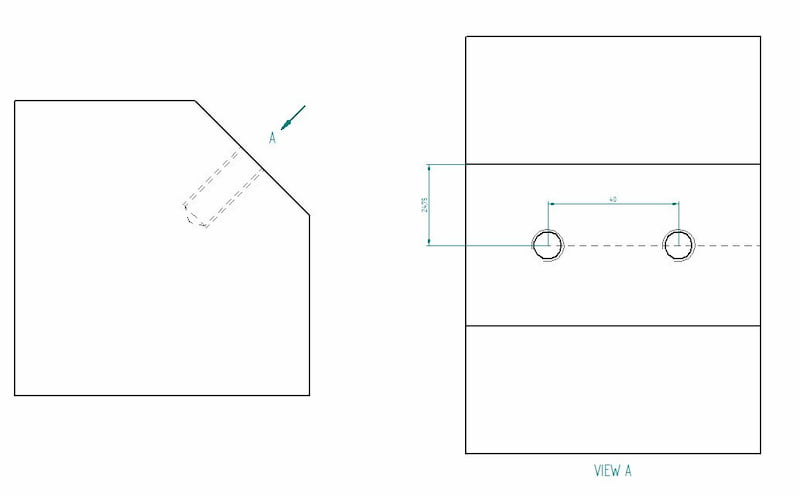
An orthographic view to represent planes that are not horizontal or vertical. Information technology helps to prove inclined surfaces without whatever distortion.
Dimensions
As said earlier, new CNC machines are actually able to read the dimensions direct from the lines. But a traditional manufacturing drawing shows all the necessary dimensions for producing the parts.
The keyword here is necessary. Avoid using the machine-dimensioning characteristic that a lot of CAD programs offer considering they tend to show everything they can observe. For a beginner, it may seem like adding it all ensures that no mistakes can be made.
Actually, it tin result in a disruptive web of measurements that is left for the manufacturing engineer to untangle. Too, calculation all dimensions you tin find makes it hard to pinpoint which ones are the most important.
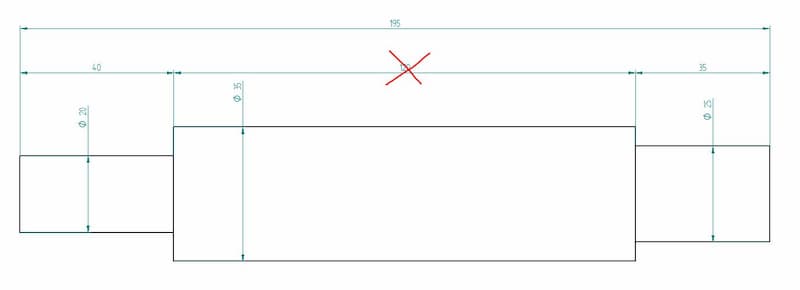
The image above shows a shaft with all the measurements. In reality, it creates a closed system whereby the manufacturer cannot guarantee all these dimensions 100%. Therefore, you have to decide the about of import ones. In our case, we chose the end steps to be more important than the length of the primal function. Thus, we should delete the 120 mm dimension.
One crucial bit of data that is missing from CAD models is geometric dimensioning and tolerancing (GD & T). For example, when looking to produce a shaft for a bearing organisation, limits and fits are of loftier importance. The right dimensions can guarantee a longer lifetime with less maintenance.
While you lot can fetch all the dimensions automatically by clicking the measure button, adding engineering science tolerances needs manual action.
Therefore, adding dimensions with lower and upper limits or fit classes is still important. Regarding Fractory'southward service, nosotros would ask you to enclose a split cartoon with these parameters. Note that you do not have to provide the whole dimensioning – just include the tolerances of a unmarried pigsty on your engineering drawings if necessary.
Data Blocks
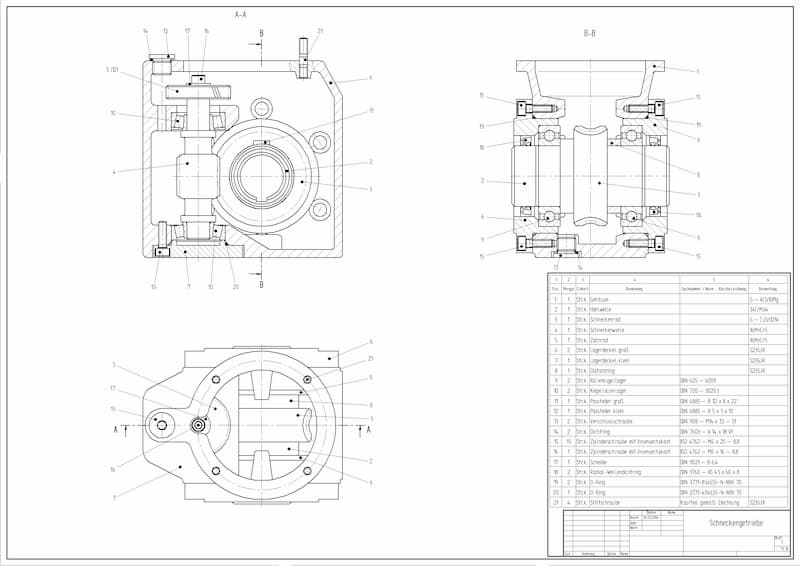
The little boxes in the lesser right corner prove boosted data. The title cake includes the author'south proper noun, office name, office number, quantity, coating, scale, etc. There can be much more info on there only the championship blocks vary widely between different companies.
Information blocks besides include a beak of materials, or BOM for short. These blocks list all the components used in the assembly, along with additional data like quantities, part names, etc.
Associates Drawings
Many engineers' drawings make the mistake of trying to include all the information about each private part in an assembly drawing. To avoid this, remember the purpose of these engineering drawings during the cosmos process – they must make the assembling easy.
Exploded views, section views, numbered parts, general dimensions, cutouts, item views (or shut-ups) are all tools you lot can apply to achieve this goal.
It should be articulate where each role goes and how it is attached – whether it needs welding, bolted connections, riveting or something else. The bill of materials is in that location to assistance you, so make sure the data available in that location is correct regarding part numbers, names and quantities.
Keeping everything above in heed will help you create assembly drawings that make life easier on the shop floor. A piece of nifty communication I once received goes like this – go along the thinking in the drawing-room. Fugitive multiple interpretation possibilities at subsequently steps will significantly decrease the number of errors.
What Does the Future Hold?
Engineering drawings are still a large part of an engineer'southward job. All in all, making them contributes to about twenty% of a design engineer's work time.
We at Fractory are trying to salvage this fourth dimension by automating the reading of 3D models for product. This leaves engineers with the job of producing associates and GD&T drawings just. The purpose is to keep the focus on engineering better products.
The engineering science community is seeing this motion equally a new trend. But as we all know, taking the whole manufacture up to a new standard takes a lot of fourth dimension. Thus, if you still outsource your production to manufacturing companies who need drawings, you must know the basics at the very to the lowest degree.
Leaving room for interpretation creates a state of affairs where your thought may non be executed as planned. And there is nobody else to arraign but the author.
So consider this stage of the production development process equally an integral role that requires thinking along. Keep the thinking in the drawing-room.
Source: https://fractory.com/engineering-drawing-basics/
0 Response to "Types of Plane in Engineering Drawing"
Post a Comment